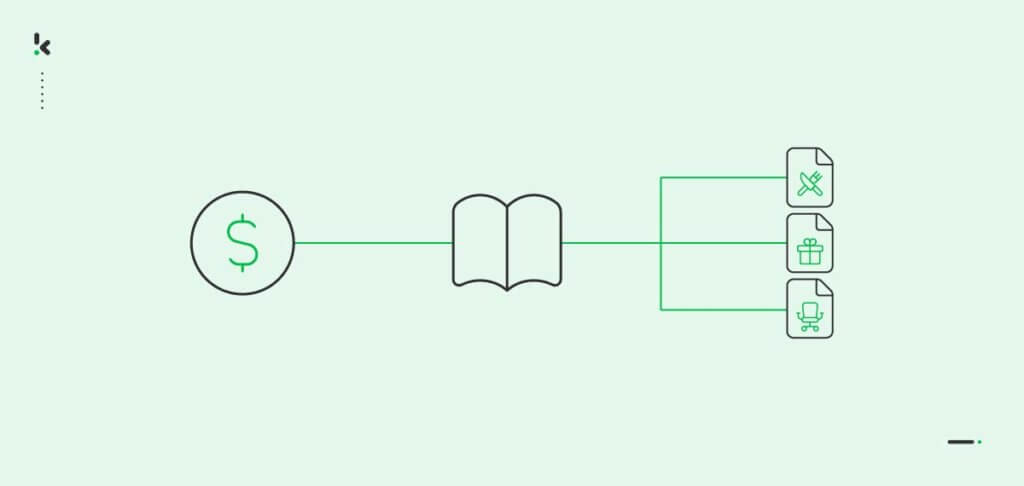

Effectively overseeing your business expenses is vital for transparency and expense control. In the absence of a specialized petty cash system, businesses may encounter delays in reimbursing employee expenses and face challenges in precisely monitoring and handling minor, routine costs. This can result in increased administrative loads, workflow interruptions, and employee dissatisfaction due to delayed reimbursements.
In this blog, we’ll explain the traditional approach to managing petty cash and, ultimately, introduce you to a smarter and more efficient solution for optimizing expense management.
What is a Petty Cash Book?
A petty cash book is a manual accounting system that businesses use to record petty cash expenses that are inconvenient to process through the regular accounts payable system. Organizing records by date makes data maintenance, management, and retrieval easier when the exact date is known.
Compared to a cash book, which contains larger amounts, the petty cash book records smaller and recurring spending. This allows for more precise control and tracking of regular, and minor transactions, and helps with the effective petty cash reconciliation.
How to Use a Petty Cash Book
A petty cash book is used as an accounting system for documenting smaller expenses incurred in a company’s daily operations. The date, the credited amount, the total value of the current petty cash, and any additional notes are entered in the credit column.
When utilizing petty cash, employees typically seek reimbursement afterward. In such instances, the employee presents the receipt for their purchase, commonly referred to as a petty cash voucher. When the employee exchanges their cash receipt, the cash manager enters the details in the cash book on the “Debit” page. The date, transaction value, purpose, and running total are entered.
Eventually, the costs stored in the petty cash fund are categorized and integrated into the general expenses system. This step is crucial for maintaining financial control within the company and to forecast the future budget.
Which Types of Petty Cash Systems Are There?
There are usually two different ways to manage petty cash using different petty cash systems. The following sections explain the two petty cash systems: The ordinary system and the imprest system.
The ordinary system
In the ordinary cash register system, there is no fixed amount and it is not mandatory to bring it back to a set amount after each use. The cashier records and submits all expenses for review by the head cashier before requesting new funds.
While the custodian typically maintains expense records, there is no strict rule to bring the amount back to a specific amount after each reimbursement. Refills may occur less frequently and there may be less focus on maintaining a consistent balance. The custodian can request a refund if necessary, without waiting for the fund to be completely exhausted.
The imprest system
Most companies use an imprest petty cash system. That means that a predetermined amount of money (imprest) is supplied for a specific period. The money will be set in the petty cash box.
If the petty cash fund runs out due to expenses, the custodian of the petty cash fund will request a refund of the exact amount spent. The custodian bank is required to provide receipts or receipts for all expenses.
The system is regularly replenished to maintain the original imprest amount, ensuring efficient control and tracking of minor expenses.
Petty Cash Book Example
Below is an example of how expenses are noted down in a petty cash book. The sample fund contains a total of €300.
| Date | Voucher No. | Particulars | Quantity | Purchase Amount | Balance |
| 02/11/2023 | Opening Balance | 1 | 300 | ||
| 10/11/2023 | 123456 | Lunch | 1 | -82.79 | 217.21 |
| 11/11/2023 | 123457 | Birthday Present | 1 | -26.77 | 190.44 |
| 23/11/2023 | 123458 | Office Supplies | 1 | -79 | 111.44 |
Disadvantages of Using a Petty Cash Book
While utilizing a petty cash book presents an affordable and straightforward approach to handling minor expenses, it comes with inherent disadvantages.
The manual recording of expenditures introduces a high risk of errors, demanding consistent review and verification. This requires resources that could be devoted to more critical tasks, as the manual process consumes time that could be used more valuably.
Additionally, the need to keep the cash book in a single location for specific individuals limits flexibility and complicates the monitoring of responsible persons. As only one person can access the cash book at a time, it becomes challenging to maintain a comprehensive overview of those accountable.
The Modern Alternative to Using a Petty Cash Book
Managing a secure and precise petty cash system requires addressing various measurements, entailing significant investments of time and human resources.
Klippa’s expense management solution, on the other hand, provides a streamlined substitute for manual petty cash tracking. This solution presents a fully automated and digital approach for submitting, approving, and overseeing expenses via its web and mobile applications, effectively addressing these challenges.
This ensures the avoidance of misplaced or replicated files. Moreover, the utilization of expense cards, seamlessly integrated with the expense management system, eradicates the necessity for employers to make upfront payments and establishes a specific budget for business expenditures.
If you are ready to simplify your expense management with Klippa SpendControl, don’t hesitate to book a free demo below!